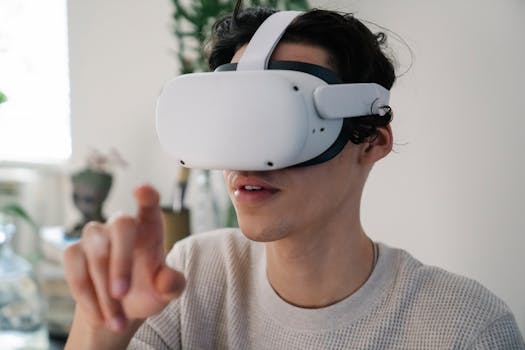The Future of Augmented Reality
Augmented Reality (AR) has emerged as a transformative technology with the potential to revolutionize various sectors, from gaming and entertainment to healthcare and education. By overlaying digital information onto the physical world, AR enhances our perception of reality and provides new ways to interact with our environment. This article explores the future of AR, examining its current applications, potential advancements, and the challenges that lie ahead.

Current Applications of Augmented Reality
AR technology is already making significant impacts across various industries. In retail, companies like IKEA use AR apps to allow customers to visualize furniture in their homes before making a purchase. This not only enhances the shopping experience but also reduces return rates.
In healthcare, AR is used for surgical planning and training. Surgeons can use AR glasses to view 3D models of patients' anatomy overlaid on their bodies during operations. This improves precision and outcomes. Educational institutions are also leveraging AR to create interactive learning experiences, making subjects like history and science more engaging for students.
Gaming is another area where AR has gained immense popularity. Games like Pokémon GO have demonstrated the potential of AR to create immersive and interactive experiences that blend the virtual and real worlds seamlessly.
Technological Advancements in AR
The future of AR is closely tied to advancements in hardware and software. One significant development is the improvement of AR glasses. Companies like Microsoft with their HoloLens and Google with their Glass Enterprise Edition are leading the way in creating more lightweight, comfortable, and powerful AR glasses.
Another key advancement is in computer vision and machine learning algorithms, which enhance AR's ability to understand and interpret real-world environments. This enables more accurate object recognition and interaction, making AR applications more intuitive and effective.
5G technology also promises to elevate AR experiences by providing faster data transfer rates and lower latency. This will enable real-time processing of complex AR applications, such as remote assistance and collaborative work environments.
Challenges Facing Augmented Reality
Despite its potential, AR faces several challenges that need to be addressed for widespread adoption. One major challenge is the high cost of AR devices. While prices are gradually decreasing, high-end AR glasses remain out of reach for many consumers and businesses.
Privacy concerns also pose a significant challenge. As AR devices continuously collect data from users' surroundings, ensuring this data is securely stored and used ethically is crucial. Regulatory frameworks need to be established to protect user privacy while fostering innovation.
Another challenge is content creation. Developing high-quality AR content requires specialized skills and significant resources. Tools and platforms that simplify AR content creation are essential for broader adoption across different industries.
The Future Impact of Augmented Reality
The future impact of AR extends beyond current applications. In retail, we may see virtual fitting rooms becoming mainstream, allowing customers to try on clothes without physically wearing them. This could revolutionize online shopping by reducing return rates and improving customer satisfaction.
In education, AR could transform traditional classrooms into dynamic learning environments where students can interact with 3D models and simulations. Subjects like biology, chemistry, and history could be taught in more immersive ways, enhancing comprehension and retention.
The workplace could also see significant changes with the integration of AR. Remote collaboration could be enhanced through virtual workspaces where team members can interact with shared 3D objects in real time. This could improve productivity and innovation in various fields.
Key Players in Augmented Reality
| Company | Product | Industry Focus |
|---|---|---|
| Microsoft | HoloLens | Enterprise Solutions |
| Glass Enterprise Edition | Healthcare & Manufacturing | |
| IKEA | IKEA Place App | Retail |
| Niantic | Pokémon GO | Gaming & Entertainment |
| Zappar | Zappar Studio | Marketing & Advertising |
The Role of Augmented Reality in Everyday Life
As AR technology continues to evolve, it will become increasingly integrated into our daily lives. From navigation apps that provide real-time directions overlaid on streets to social media filters that enhance photos and videos, AR will offer new ways to interact with our surroundings.
- Navigation: Apps like Google Maps are already experimenting with AR features that overlay directions on the real world through smartphone cameras.
- Social Media: Platforms like Snapchat and Instagram use AR filters to create engaging content that users can share with friends.
- Home Improvement: Apps allow users to visualize home renovations or furniture placements before making any changes.
- Tours: Museums and tourist attractions offer AR-guided tours that provide additional information about exhibits or landmarks.
- Agriculture: Farmers use AR to monitor crop health by overlaying data collected from sensors onto their fields through smart glasses.
The future of augmented reality is promising, with numerous potential applications across various sectors. As technology advances, we can expect even more innovative uses for AR that will enhance our interactions with both the digital and physical worlds.
The Future Landscape of Augmented Reality:
The future of augmented reality holds immense promise across diverse fields such as retail, healthcare, education, gaming, and beyond. As hardware becomes more affordable and software more sophisticated, we can expect wider adoption of this transformative technology. The integration of 5G will further enhance these experiences by enabling real-time processing capabilities essential for complex applications.
The challenges facing augmented reality include high costs, privacy concerns, and content creation complexities. However, ongoing advancements in hardware design, computer vision algorithms, machine learning technologies combined with proactive regulatory measures will help overcome these obstacles paving way for a more immersive future enriched by augmented reality experiences.
References: microsoft.com, google.com, nianticlabs.com , zappar.com .